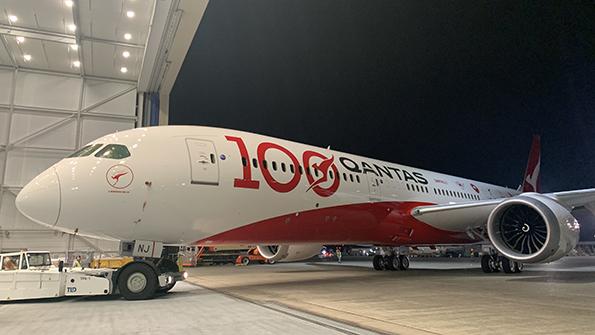
An incident in which a Qantas Boeing 787 completed a transpacific flight with its engine fan cowl static ports covered with tape highlights the importance of specific instructions that cover maintenance and preflight preparation procedures.
The September 2021 Melbourne-Los Angeles flight, which carried only cargo, took place after the aircraft—VH-CNJ— sat for about 40 hr. following its previous flight, an Australian Transport Safety Board (ATSB) report found.
Qantas followed its “normal” parking procedures, adhering to Boeing’s recommendations for parking aircraft for seven or fewer days. Among the recommended tasks: covering all 14 static ports, including the four fan cowl ports, two of which are located along the bottom of the fan cowl on the front nacelle of each engine.
A Qantas engineer carried out the procedures using an airline-specific aircraft-parking job card. The job card referenced the 787-9 aircraft maintenance manual (AMM), which identified the locations of all ports. The card included Boeing’s instruction to tape down the bright orange “remove before flight” barricade, or streamer, tape near the fan cowl port to prevent strong winds from blowing it off. The engineer followed the card but did not have access to a lift, so two ports on the tail were not covered.
Nine hours later, a second engineer was tasked with preparing the aircraft for its flight to Los Angeles, scheduled for the following morning. The applicable job card “included the tasks ‘remove all barricade tape and adhesive tape from all of the static ports’ and ‘remove the static ports covered tag,’” the ATSB found. “The AMM procedure for static port cover removal was not referenced” on the card, the board stated.
The second engineer saw the logbook note about the tail ports being left uncovered and visually verified their status.
“This was to ensure the ports had not been subsequently covered but inadvertently not entered in the technical log,” the ATSB said.
The engineer did not check the engine fan cowl ports.
Preparation for dispatch the following day included a third engineer’s sign-off that all maintenance tasks were done. The procedure did not require visual inspection of the aircraft.
A second officer (SO) assigned to the flight conducted a walk-around, following the flight manual’s instructions. The manual included a specific path to follow and a reminder to ensure all ports were uncovered but did not list the ports or show them on the walk-around diagram. The SO did not see the covered ports.
Dispatch of 787s in Melbourne was handled by Dnata, a Qantas contractor. Dnata’s procedures for the walk-arounds do not list the ports specifically but instruct personnel to report any observed “abnormalities.”
A dispatcher conducted a walk-around but did not see the tape. The dispatcher “was not aware of the static ports,” the ATSB said, and may not have questioned the tape, as “there are [Qantas] engineers there all the time . . . so we don’t even think to question it.”
The flight to Los Angeles was uneventful. The covered ports were discovered during a post-flight inspection by a Qantas engineer.
The 787’s engine cowl ports are important but not flight-critical. They serve as a backup to the fuselage ports, which feed air pressure data to the air data reference system, which is then used by the electronic engine control (EEC). “Where no ambient pressure data is available, the EEC assigns a fail-safe mode for continued engine operation,” the ATSB said.
The investigation found several shortcomings in both Boeing’s and Qantas’ technical documentation.
“Qantas procedures did not identify all of the aircraft’s static ports, and the procedure for restoring the aircraft back to service did not reference Boeing procedures,” the ATSB wrote. “This allowed different interpretations of which ports would be covered.”
Boeing’s recommendation to fasten both ends of the streamer tape to the engine (rather than leaving one end hanging down, as is often done) made it less likely that it would be noticed by personnel on a walk-around.
Qantas has updated its maintenance procedures to provide references to the applicable Boeing steps. The airline also developed a walk-around video tutorial for flight crews and issued memos to both engineering and flight operations personnel highlighting the fan cowl ports. It also issued a memo to ground support personnel emphasizing the importance of flagging any issues noticed during pre-dispatch checks.
Dnata said it has added specific reminders to pre-shift briefings.
Boeing plans to update its recommended procedures to include placing a placard in the cockpit that specifies that the cowl ports are covered. The current procedure calls for placing a sign on one control wheel when ports are covered but does not suggest listing which specific ports.
“When performing safety‑critical tasks like aircraft maintenance, it is very important that procedures are clear and unambiguous to avoid misinterpretation and error such as occurred in this incident,” the ATSB said. “Targeted inspection of locations and components, rather than relying on streamers, which can detach, can help to identify when these covers or devices have not been removed.”





